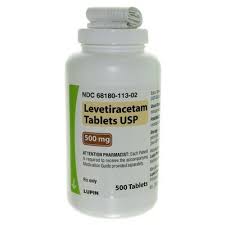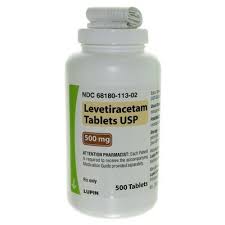Providing Quality & Trust || Clinic Website
Levetiracetam Tablets
Accord Healthcare Inc
$0.17 - $0.21
$0.17 Each
Detailed Description
Levetiracetam
(leh-vah-teer-ah-see-tam)
- Description: Anticonvulsant
- Other Names forthis Medication: Keppra®
- Common Dosage Forms: Veterinary: None
How is this medication useful?
In dogs, levetiracetam is sometimes used to treat seizures, especially when other more commonly used drugs are not effective or tolerated.
The FDA (U.S. Food & Drug Administration) has approved this drug for use in humans butitis not officially approved for use in animals. The FDA allows veterinarians to prescribe products containing this drug in different species or for other conditions in certain situations.
- Levetiracetam is a broad-spectrum anticonvulsant that can be used as adjunct therapy for refractory canine epilepsy or when either phenobarbital or bromides are not tolerated. Dogs may become refractory to therapy over time.
- In cats, levetiracetam may be used as a second-line drug when phenobarbital alone does not control seizures but can also be tried as sole therapy when phenobarbital is not tolerated.
- Appears to be well tolerated; adverse effects may be transient and can include sedation in dogs and lethargy and decreased appetite in cats.
- In dogs, phenobarbital may cause significant drug interactions with levetiracetam.
- Dosing frequency (every 8 hours) of immediate-release tablets and oral solution may be impact owner compliance.
- Cost has been an issue but is decreasing with the availability of generics.
- Immediate-release tablets should not be confused with extended-release tablets when prescribing and dispensing.
You and your veterinarian can discuss why this drug is the most appropriate choice.
Available:
- 250 mg and 500 mg tablets
Uses/Indications:
Levetiracetam can be useful as adjunct therapy to phenobarbital and bromides in patients with refractory canine epilepsy. Convincing evidence for efficacy of levetiracetam monotherapy is lacking. Levetiracetam has been shown to be useful in the treatment of status epilepticus and acute repetitive seizures (ie, cluster seizures) in dogs. It has been used at home for oral pulse therapy to abort seizure activity, and SC administration at home may be useful in dogs that develop status epilepticus or acute repetitive seizures that do not always respond sufficiently to benzodiazepine (via rectal and/or intranasal administration). In addition, in a study, IV levetiracetam was used successfully to treat refractory seizures in a dog that ingested a lethal dose of fluorouracil (5-FU). Levetiracetam may have reduced efficacy in dogs over time (ie, “honeymoon effect”), and there have been reports that phenobarbital can significantly affect levetiracetam pharmacokinetics in dogs. Lack of efficacy has also been noted when levetiracetam was used as adjunct therapy in dogs with refractory epilepsy.
Levetiracetam appears to be useful as add-on therapy in cats when phenobarbital does not control seizures or alone in cats that are unable to tolerate phenobarbital. Studies have shown levetiracetam to be more effective than phenobarbital and well tolerated as a monotherapy agent in cats with myoclonic seizures.
Pharmacokinetic data in horses suggest that levetiracetam may be efficacious when given orally.
Adverse Effects:
Levetiracetam appears to be well tolerated in dogs and cats. The most common adverse effects reported include sedation and ataxia in dogs and reduced appetite, ataxia, hypersalivation, and lethargy in cats. These effects may be transient. Changes in behavior and GI effects can occur. Transient head-lowering has been observed in horses.
In a study, IM administration produced less muscle inflammation in dogs than did the saline control solution. In another study, SC administration of undiluted levetiracetam solution for injection was well tolerated, but the sample size (n = 4 healthy dogs) was small.
A systematic review and meta-analysis of adverse effects of antiepileptic drugs in dogs showed a strong level of evidence for levetiracetam’s safety profile as monotherapy and adjunct therapy. Only type I adverse effects (ie, dose dependent, predictable) were reported and included vomiting and sedation, followed by ataxia and hyperactivity. Less common adverse effects included anorexia, polyphagia, and polydipsia, followed by polyuria, diarrhea, aggression, disobedience, and attention-seeking.
In humans, adverse effects include sedation, asthenia, anxiety, and headache. Neuropsychiatric adverse effects (eg, aggression, agitation, irritability, depression) have also been reported. It is recommended to withdraw the drug slowly to prevent withdrawal seizures.
What are the side effects ofthis medication?
Levetiracetam is usually well tolerated in dogs or cats.
Side effects that are usually not serious include:
- Dogs: tiredness, lack of energy. You don’t have to be overly concerned if you see any of these signs unless they are severe, worsen, or continue to be a problem.
Contact your veterinarian if this happens.
Side effects that may be serious orindicate a serious problem:
- Sudden changes in behavior.
If you see this effect, contact your veterinarian immediatelyContact your veternarian or pharmacist with any other questions.
Precautions/Warnings:
Levetiracetam is contraindicated in patients that have previously exhibited hypersensitivity to it or any of its components. It should be used with caution in patients with renal impairment; changes in dose amounts or frequency should be considered. Respiratory failure and cardiac arrest were reported in a dog with cluster seizures that received an undiluted levetiracetam injection of 60 mg/kg IV. In humans, renal elimination of levetiracetam correlates with creatinine clearance.
Anecdotally, it has been reported that extended-release tablets may not fully disintegrate in the canine GI tract. Some neurologists have had experience with this situation and found that these patients still had levetiracetam levels within the therapeutic range. The presumption amongst many neurologists is that what is found in the stool is the matrix of the pill and that the medication is still being absorbed.
LevETIRAcetam should not be confused with levOCARNitine or levOFLOXacin. Immediate-release tablets should not be confused with extended-release tablets when prescribing or dispensing.

Powered by nopCommerce
This site is running in live payment mode. Real payments will be processed.

